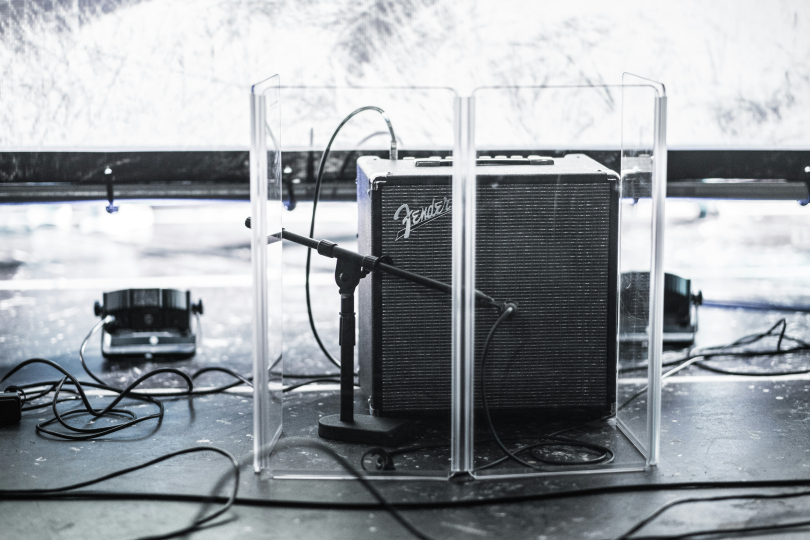
Tubes vs. Algorithms #3: Praxis and Future Development
In the past two episodes of our miniseries, we discussed classic guitar amps and modellers/profilers in terms of their historical development and technology. In this last episode, we'll try to list all the possible combinations of their use and also speculate where future developments in this area may go.
What do we actually hear?
The tough guys who haven't "gone soft" must have a good wall of Marshalls or Bugin behind them on stage, don't they? Alternatively, some other brands, but in a similar lineup – upward amps at the bottom, angled ones on top of them, and then amp heads on top. That's what a stage should look like when you're playing rock'n'roll.
However, on closer examination, one finds that the SM57 microphones are only in one, at most two amps out of the two rows and columns. Strange, isn't it? It's even stranger when you notice that, apart from those two amps with microphones, the rest are all empty cabinets without speakers, and so are the heads, all but the two are gutted inside and in fact are just plywood dummies. But, as one unnamed guitarist said, "It has such a nice festival look to it."
And what do the people in the audience actually hear? Is it the sound from the four-by-twelve amps? Not at all. Sure, that's the foundation you couldn't do without, but then it goes to the preamp and the mixing console, then maybe to some other processors and the "non-guitar" PA speakers. And after all of that, into the listeners' ears.
Anyway, to afford all that, you need roadies and a truck. If you drive your station wagon (at best) to the small clubs where you usually play, you can either laugh at this kind of shenanigans or be green with envy.
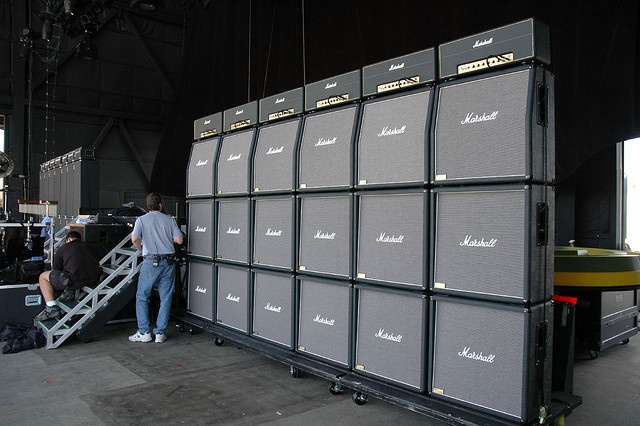
What is everyone looking for?
So, how do we guitarists search for the perfect sound? First, we have to create one in our heads. This starts with identifying guitar sounds on recordings and live gigs and deciding whether we like them or not. That's how we gradually weave our vision. And (thankfully) we all have slightly different ones. The sound might be rounder or sharper, not distorted at all, or with a lot of distortion. With more or less hall or echo and so on. Usually, we like the sound of one or a few players, which we try to replicate in our limited conditions. There's nothing weird or wrong with that. That's just the way it is.
Of course, during this process, we can discover something that works for us, that sets us apart from others, and we can create a new distinctive sound. It might enhance the uniqueness of our playing style, and that's the best thing that can happen to us. We become recognizable. The beauty of it is that the possibilities are endless and it's just a matter of imagination, patience and, to be honest, a little bit of cash in your pocket.
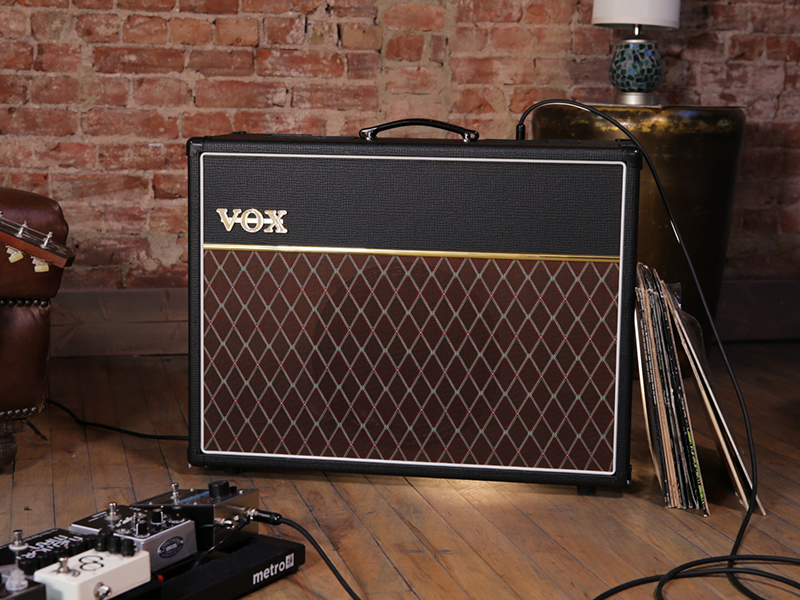
What is "Amp In The Room"?
But what was the sound that inspired us and where did we hear it? Well, this is the moment of truth! The answer is: on a recording, or at a gig where our favourite guitarist was playing. Only a tiny percentage of people have had the opportunity to sit in a room with their guitar idol and listen to their sound straight from the speaker of a guitar cabinet or combo.
And this is where we get to the core of the dispute between the fans of classic amplifiers on the one hand and modellers/profilers on the other. The term "amp in the room" refers to the immediate perception of the guitar sound that follows the trajectory: guitar-effect before the input or an effect in the loop (optional)-combo or head preamp-power amp-combo or head preamp-speaker-ear. Orthodox tube amp proponents quite rightly claim that a guitar modeller/profiler, even with the best FRFR (full range/flat response) monitor, will never sound as nice as a tube amp through a guitar speaker.
And that is (so far) the holy truth. But where does it work this way? In a shop, at home or in a friend's living room. And then also maybe in the recording studio before the sound is picked up by the microphone, and of course on stage before the sound is picked up by the microphone. But where does this sound land unaltered and "undigitized" in the listener's ear? Only in the shop or in the living room. Of course, it's great when we listen to the beautiful sound of a Celestion or Eminence in the studio or on stage. It can please us, it can inspire us. But listeners hear different waves. How different depends on the circumstances.
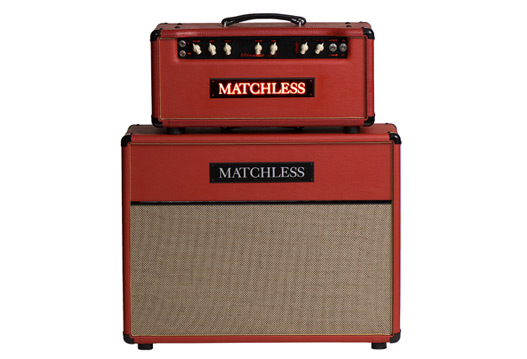
A lot of things can happen on stage
For example, this (my true personal experience): my bandmate, a guitarist, had a stunning Marshall Plexi head on stage for the first time. It played through an original 4x12 cabinet. The sound on stage was absolutely amazing – everything you want to hear: tone, articulation, frequency balance, just great. About halfway through the concert, I noticed people peeking at the stage, and then around the third song the sound engineer appeared.
My colleague was enjoying the glorious "plexiglass" sound, but it was clear at that moment where the problem was. The age-worn arm of the microphone stand, originally aimed at one Celestion speaker, resembled ... well, you know what. The microphone wasn't pointed at the speaker, but straight to the ground. What frequencies it was picking up there I can only guess, but it certainly wasn't pretty, judging by the looks of the listeners and the sound guy scurrying around.
This is certainly an extreme and unique situation, but still, what does your audience hear if you don't have a full-time, well-trained sound engineer with his own equipment? Are you sure that the gentleman behind the desk, who you met for the first time, knows what kind of sound you want out there?
Given the circumstances, the scores of the competitors (I mean amps vs. modellers/profilers) are starting to even out. For in the case of a modeller, your on-stage FRFR monitor, as well as any in-ear pickup, sounds very much like the PA aimed towards the audience, as long as you ask the sound engineer not to interfere significantly in frequency or dynamic range. If they do, it should be only to level up the frequencies of the instruments in the band. Neither the microphone nor the stand can ever let you down, and the difference between the stage sound of the guitar speaker and the sound from the PA is minimised. And that's something worth thinking about.
Actually, everything I've said so far is perfectly compiled into this video:
The New Era
Until recently, before the modeller/profiler emulations of real amplifiers were as perfect as they are now, professional musicians used hardware, usually tube setups, and modelling was only used as a potential supplement for "exotic" sounds, effects and so on. But semi-professionals and amateurs, especially those who perform on smaller stages, play in multiple bands and need to be flexible, have gotten used to the digital alternative as a more practical option.
However, today the situation is changing quite significantly. New digital devices started to feature as central components in the stage setups of prominent guitarists. For example, Steve Vai, known for his long-time collaboration with Carvin, which was made famous by the Legacy model, can often be seen with a box containing a Fractal Axe-Fx III and two Fryette power amps. On the other hand, Neal Schon uses a combination of Axe-Fx III and FM9. Pat Metheny has a Kemper and Dave Mustaine has two Quad Cortex models.
Is this a sign of the end of tube amplifiers? I don't think so. They will form part of the music industry for many years to come at least. They'll just increasingly become a tool used by enthusiasts and a luxury rather than a must-have.
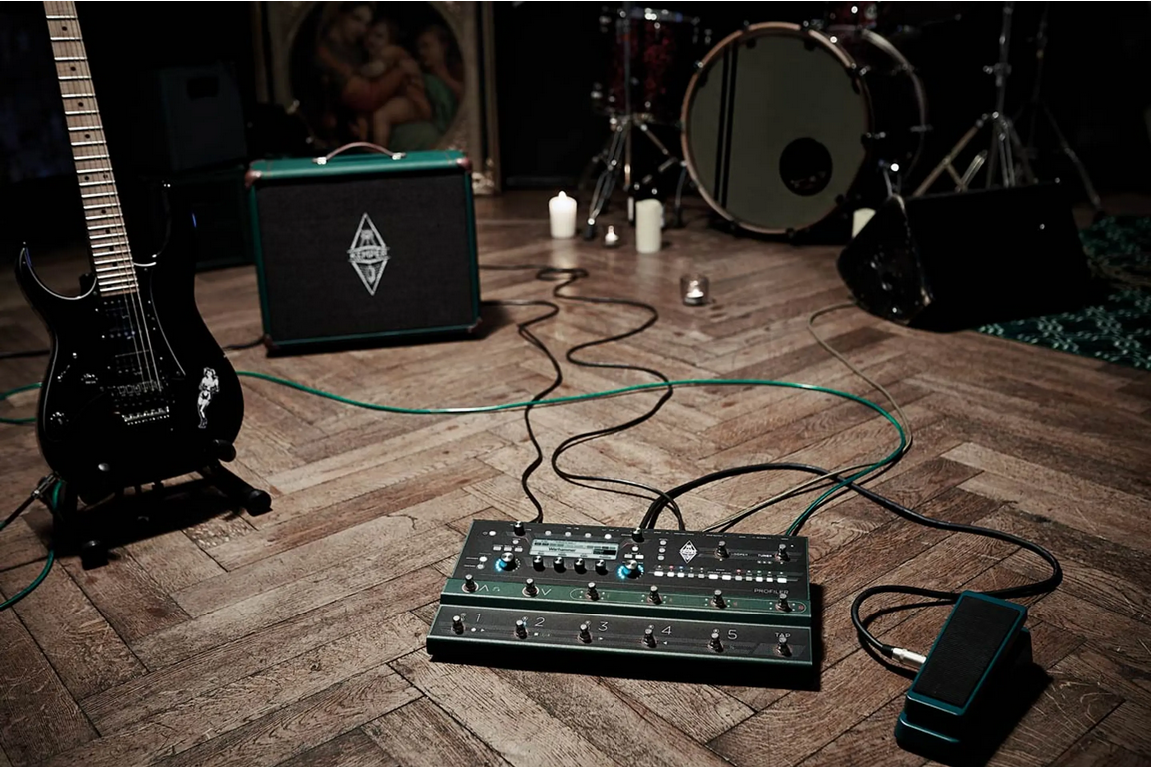
Something from the user manuals
How to use a guitar amplifier and a cabinet or combo is probably clear to everyone. From the guitar, the cable goes directly to the amp or an effect and then to the amp. From the amp, the cable goes to the cabinet. If the amp has an effects loop, there may be some other effects that sound better after the preamp. And that's it. On stage or in the studio, a microphone (or even multiple microphones) is needed to pick up the sound from the guitar speaker, which then travels through various processing stages to the listener's ear. The exception to this may be amps that have built-in cabinet simulation (Revv, Suhr, Koch, etc).
In the case of digital devices (I'll call it a "unit" for simplicity), the range of possible uses is considerably wider. Let's try to list the most common ones:
1. We want to play directly from the unit (for ourselves or for others)
An active FRFR monitor (or two to a stereo) is connected to the floor-based or rack version of the unit. Another cable can go to the mixing console if we want to record something, or we are on stage. In any case, we won't need any microphone and we will connect from the balanced output.
2. We want to record on the computer
Since most units have a USB output and also serve as an audio-to-digital converter, we can connect the unit directly to a computer and record into our favourite DAW (digital audio workstation). In that case, we'll probably hear ourselves through studio monitors connected to the computer or headphones.
3. We want to play via a neutral power amp and a guitar cabinet
For this purpose, we have a unit, an amplifier that is frequency neutral and a 4x12 guitar cabinet. The unit serves as a preamp, a power amp and an effects processor. Presumably, in such a setup, we keep the power amp emulation, but turn off the guitar cabinet emulation, because we have a real one.
4. We want to use the unit in combination with a guitar power amp and a cabinet
This can be a guitar power amp in a combo or head, or a standalone amp, like a tube amp. In most cases, we'll probably plug the output of the unit into the FX return or input of the amp and turn off the emulation of the power amp and the cabinet. The unit thus serves as a preamp and effects processor.
5. We want to use the unit only as an effects processor ("pre" or "post")
In this case, we use our favourite combo or head plus a cabinet and use the unit either only for the effects that are placed before the preamp (that is, compression, distortion, wah, whammy, etc.) or those that are placed after the preamp, i.e. into the effects loop (modulation, delay, reverb, etc.). In the first case, the output of the unit will go to the standard "instrument" input on our real amp, in the second case we will need two cables and they will go from the output of the effects loop to the unit and from there to the input of the loop. Obviously, we'll turn off the simulation of both the preamp and power amp in the unit, as well as the cabinet.
6. We want to connect a guitar amplifier to the unit using the 4-cable method (4CM)
If we want to use the unit as an effects processor both "pre" and "post", it is necessary to have an effects loop on a real guitar amp or combo. Then we will "wire" as follows:
a) guitar to "instrument" input in the unit
b) from the loop output in the unit to the loop input in the amp (return)
c) from the loop input in the unit to the loop output in the amplifier (send)
d) from the unbalanced output in the unit to the "instrument" input on the amplifier.
But we must take a few important steps when setting up the unit. Obviously, we'll turn off the preamp, power amp, and cabinet simulation and use only effects, but we also need to include a block called Loop or Send/Return in the signal chain. This splits the signal so that the "pre" effects are placed at the output going to the guitar input of the amp, and the "post" effects go into its effects loop.
It is clear from the above that there doesn't always need to be a "life and death struggle" between tube amps and modellers/profilers, but a "peaceful co-existence" can also occur, using the advantages of both.
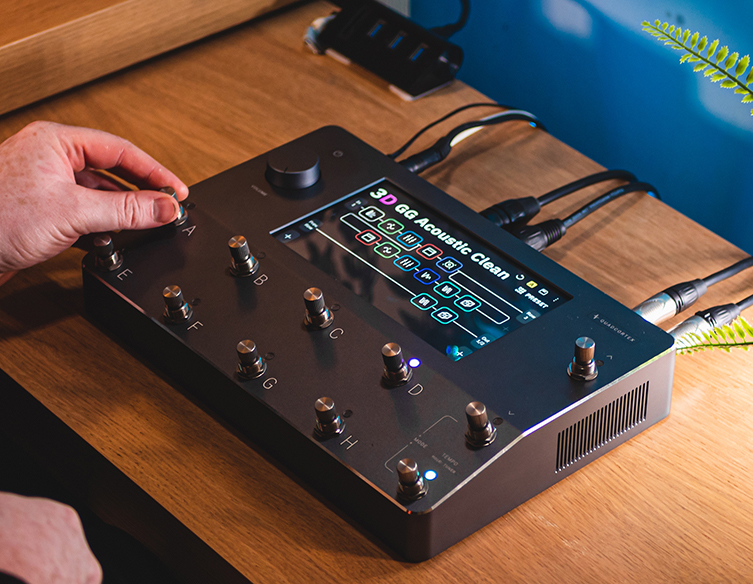
What's next?
Now let's speculate for a moment where this is all heading. Let's assume that development proceeds at the current pace, and let's disregard the fact that Google, among others, is working on the Willow quantum chip. Such a component, if it could be put into practice, would significantly multiply computational power and that would imply two possibilities: either a leap in humanity's evolution or its extinction (either by conflict or by technology). But let's just say it'll probably continue as it has so far. I'll try to act as an amateur futurologist and come up with possible scenarios.
1. Much better simulations
Machines will certainly analyse and replicate the behaviour of real circuits with unprecedented accuracy. Machine learning will allow us to simulate not only the amplifiers as a unit but also the interaction of different components such as tubes, transformers or speakers.
2. Personalised settings
AI will perfectly analyse each player's playing style and recommend or directly create unique amp and effect settings based on their preferences. This will allow guitarists to easily achieve their dream sound without having to experiment with settings (in other words, "wiggle") for a long time.
3. Real-time audio editing
Thanks to advanced technical tools, the machine will analyse the sound parameters in real-time during the performance and automatically adjust the settings to maintain the optimal tone in different situations (for example, when changing volume or dynamics, according to the frequency response of the room, and so on).
4. Artificial intelligence as an advisor
The AI will act as a virtual assistant to help the player get the right equipment. It will answer questions like, "How do I achieve a sound similar to guitarist XY?" or "What preset should I choose for this song to best fit into the mix in terms of frequency?"
5. New sound options
The machines will certainly create entirely new sounds and effects that would not be possible with traditional analogue circuits. Generative AI will combine different features of existing amplifiers to create hybrid or completely original sounds.
6. More efficient development and updates
Manufacturers will be able to develop new models faster and update them regularly based on user insights thanks to perfect feedback. AI will automatically process data from players and come up with software improvements.
7. Affordability
Advanced technologies will reduce the cost of developing and manufacturing digital devices, which could make high-quality sound available to an increasingly wide range of players.
8. Creative possibilities
In addition to perfectly reproducing an existing sound, AI will encourage experimentation and inspiration, for example by generating never-before-set presets or mimicking the sounds of other instruments and combining them with traditional guitar sounds.
So, these are a few attempts to guess where the development will go from here. Whether any of this happens or not, the important thing is that we won't end up like in Matrix and the modellers won't decide to eradicate all tube dinosaurs and put all the amp factories out of business, or cause, say, a power surge to burn out all the traditional amplifiers. That would be a major disaster for humanity.
Even though we somehow suspect that evolution cannot be stopped and amp-modelling will become more and more perfect and successful, the sight of a well-crafted boutique piece full of gleaming tubes with proper metal knobs, leather handles and chrome rails just never gets old, not to mention the sound.
If you have found an error or typo in the article, please let us know by e-mail info@insounder.org.

